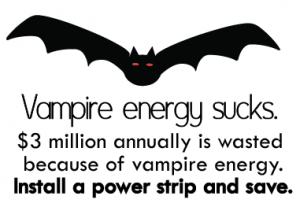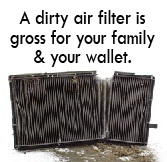It’s easy to take charge of your energy bill while helping your community and planet. Most of these tips pay for themselves immediately or in a few years! Check out the Department of Energy’s comprehensive energy savings guide for more tips, and click the links below to find more detailed help.
Low-hanging Fruit:
No-cost Actions:
- Conduct a do-it-yourself Home Energy Audit with one of these easy-follow-guides from:
- BNenergyBright (form)
- the Department of Energy (website)
- This Old House (website)
- City of Houston (document)
- City of Seattle (document)
- Set your hot water heater no higher than 120 degrees. You’ll save 15 percent of your water-heating energy.
 Program your thermostat to 68 degrees F in the winter and 78 degrees F in summer.
Program your thermostat to 68 degrees F in the winter and 78 degrees F in summer.- Install a power strip and use it to easily turn off the TV, VCR, stereo, fan, computer, printer, and other electronics all at once when not in use.
- Open curtains on your south-facing windows during the day to allow sunlight to naturally heat your home, and close them at night to reduce the chill you may feel from cold windows.
- Put your computer & monitor on the active power management mode, which can save up to $55 per monitor annually and $45 per computer annually.
- Avoid using portable or baseboard heaters, because not only are they power hogs, they are also a fire hazard.
- Check your electricity bill and compare it to your previous usage to get a sense of how you’re improving!
Laundry:
- Wash clothes in cold water whenever possible, and line dry afterwards.
- Clean the lint trap after each load.
- Make sure to not over-dry clothing. Not only does this save energy, but also your clothes.
- Dry a few loads in a row to take advantage of the dryer’s reserved heat.
Kitchen:
- Make sure your fridge and oven doors are tightly sealed so no air leaks out. A good trick to figure this out is by closing the door on a dollar bill. If you can easily pull the bill out, your appliance is not tightly sealed. If necessary, adjust or replace the gasket.
- Keeping refrigerator coils clean with a brush or a vacuum will extend the life of the refrigerator and prevent wasted energy usage.
- Use the energy saver setting on your dishwasher and clean the filter every so often.
- Run your dishwasher with a full load. Most of the energy used by a dishwasher goes to heat water.
- Avoid using the heat-dry, rinse-hold and pre-rinse features on your dishwasher. Instead use the air-dry option. If your dishwasher does not have an air-dry option, prop the door open after the final rinse to dry the dishes.
- Thaw, or partially thaw, frozen foods in the fridge before cooking.
Now take it to the next level…
- Get a comprehensive Energy Audit to identify the major energy issues in your home.
- Check your furnace filter every month. If the filter looks dirty, change it
 . At a minimum, change the filter every 3 months. A dirty filter will slow down air flow and make the system work harder to keep you warm or cool — wasting energy!
. At a minimum, change the filter every 3 months. A dirty filter will slow down air flow and make the system work harder to keep you warm or cool — wasting energy! - Is your dryer having problems drying large loads of laundry? Hire a professional to clean your dryer vents to prevent dryer fires and save energy.
- Install a water-saving showerhead.
- Use energy-efficient lighting and fixtures.
- Use a light dimmer when using regular bulbs. However, do NOT use dimmers with fluorescent bulbs.
- Use a fan instead of an air condition when possible.
- Add window tint to minimize solar heat gain and reduce your air conditioning needs.
- Plant deciduous trees outside your largest west-facing window for shade in the summer to reduce your air conditioning needs.
Energy Savings Pro:
- Block air gaps around plumbing pipes and electrical cables, windows and doors with caulking and weather-stripping.
- Buy appliances with the ENERGY STAR® label.
- Buy the smallest model of the appliance that meets your needs; smaller models often use less energy. For example, consider cooking with a slow cooker instead of an oven.
- Add extra insulation to your attic. **NOTE: Always seal your home before adding insulation.
- Insulate hot water pipes and put a water-heater blanket on your hot water heater.
- Insulate walls with cellulose or foam insulation when renovating.
- Use low-e double pane windows in new construction, additions or renovations.
- Install awnings or shades over windows on the south or west side of the building.



